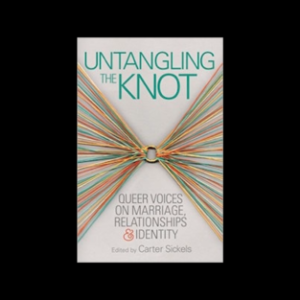Digging through the Ooligan Press backlist, eager to see the legacy of those who’ve come before me and gone on to complete their degrees, I stumbled across Untangling the Knot: Queer Voices on Marriage, Relationships & Identity and was immediately intrigued. This collection of twenty-five essays from individuals of all genders, all sexual orientations, and all walks of life proved to be one of the most powerful and insightful books I’ve picked up in many, many years.
Untangling the Knot was heartbreaking, funny, and beautifully crafted. I would recommend this book in a heartbeat to anyone interested in queer rights and issues. These stories represent a diverse group of people with differing ideas on what it means to be queer and how to exist within a world that isn’t set up for their existence. It broke open the slew of topics that have been boiled into the tiny proverbial box of “queer issues” in order to look at pressing issues in the LGBTQ+ community. And though the novel is a few years old, released just before the national ruling regarding the freedom to marry in all fifty states, the same messages ring true today: legal doesn’t mean accepted; straight marriages and queer marriages will never look exactly the same; and “queer” means something different to everyone.
As a bisexual millennial, it was an eye-opening experience to learn the perspectives and stories of so many different people in all walks of life. Growing up with supportive parents and an accepting group of friends, I haven’t experienced many of the struggles that often come packaged in the “coming-out” narrative. This sense of naivety was perhaps the driving force behind my fascination with this book, as I often seek to use my sense of comfort and confidence to help shed light on issues that are so often swept under the rug.
My favorite essay in this collection was penned by Fabian Romero, who describes her experience growing up as a Mexican woman in the United States for much of her life. She was groomed to see marriage as an end-all, be-all—a saving grace from all the things in life that could go wrong. But as a bisexual woman who “performed” her femininity rather than embraced it, that narrative would never be her narrative. She mentions her foray into addiction and substance abuse, noting that she was just one of many queer people of color who chose these coping mechanisms, but also explains that she made it out alive with a refreshed sense of self and society. It is at the end of her essay that she provokes the greatest reader response, as she explains, “I question why gay marriage is talked about as if it will solve various forms of oppression that impact LGBTQIA communities.” She draws attention to violence, discrimination, poverty, and a slew of other issues that exist in the very structure of our society and admits that for her, marriage equality is only a small step forward in the face of equal rights.
One day, I look forward to “tying the knot” with the person I love, be they male or female. But for now, in an age where queerness is becoming more accepted, editor Carter Sickels reminds us that “there is still so much work to be done.” I’m perfectly content to just keep untangling the knot instead.

